Abstract
The primary objective of this paper is to quantify a realistic pathway for Canada to reach net-zero emissions by 2050. This study analyzed greenhouse gas (GHG) emissions from the 10 provinces and 3 territories of Canada based on the emissions from their economic sectors. A time series analysis was performed to understand the trajectory of the emissions profile from 1990 to 2023. Using the 2023 emissions as the baseline, a linear reduction, based on the GHG proportions from each jurisdiction, was performed and projected to 2050 (except for Prince Edward Island (PEI), where net zero was targeted for 2040). Moreover, a machine learning technique (k-means unsupervised algorithm) was used to group all the jurisdictions into homogeneous regions for national strategic climate policy initiatives. The within-cluster sum of squares identified the following clusters: Cluster 1: Manitoba (MB), New Brunswick, Nova Scotia, and Newfoundland and Labrador; Cluster 2: Alberta (AB); Cluster 3: Quebec (QC) and Saskatchewan; Cluster 4: Ontario (ON); and Cluster 5: PEI, Northwest Territories, Nunavut, and Northwest Territories. Considering the maximum GHG reductions needed per cluster (Clusters 1–5), the results show that 0.309 Mt CO2 eq/year, 5.447 Mt CO2 eq/year, 1.293 Mt CO2 eq/year, 2.217 Mt CO2 eq/year, and 0.04 Mt CO2 eq/year must be targeted from MB (transportation), AB (stationary combustion), QC (transportation), ON (stationary combustion) and PEI (transportation), respectively. The concept of climate stabilization wedges, which provides a practical framework for addressing the monumental challenge of mitigating climate change, was introduced to each derived region to cut GHG emissions in Canada through tangible, measurable actions that is specific to each sector/cluster. The clustering-based method breaks climate mitigation problems down into manageable pieces by grouping the jurisdictions into efficient regions that can be managed effectively by fostering collaboration across jurisdictions and economic sectors. Actionable and strategic recommendations were made within each province to reach the goal of net-zero. The implications of this study for policy and climate action include the fact that actionable strategies and tailored policies are applied to each cluster’s emission profile and economic sector, ensuring equitable and effective climate mitigation strategies in Canada.
1. Introduction
The continued release of greenhouse gas (GHG) emissions and the increase in their concentration in the atmosphere are causing climate change, the impacts of which are felt globally. Unabated economic activities exacerbate the impacts of climate change, which will have serious consequences if no actions are taken. Climate change is not restricted to any geographical boundaries, and climate actions that will drastically change the current emission trends and trajectories affect all. Since GHG emissions are strongly correlated with economic growth and productivity, the highest emitters are also the largest economies. In other words, if any drastic reductions in emissions occur, they must start among the biggest economies. As of 2023, global GHG emissions (i.e., carbon dioxide (CO2), methane (CH4), nitrous oxide (N2O), and fluorinated gases) were around 53 Gt CO2 eq [1].
Canada is among the 194 countries that signed the Paris Agreement to keep the average global temperature rise below 2 °C and limit the increase to 1.5 °C. From a strategic policy standpoint, Canada created the lofty 2030 Emissions Reduction Plan through an economic sector pathway for Canada to reach its “emissions reduction target of 40% below 2005 levels by 2030 and net-zero emissions by 2050” [2,3]. Canada comprises ten provinces and three territories, all with different economic capabilities and GHG trajectories; therefore, to meet this goal, there is a need for targeted, context-specific strategies that address Canada’s diverse economic and geographic landscape using historical GHG data. For example, oil and gas GHG emissions are high, contributing around 30% (i.e., ~208 Mt CO2 eq) [3] of the national emissions in 2023 and are concentrated in British Columbia, Alberta, and Saskatchewan. Similarly, Ontario’s emissions are driven by transportation and buildings. Moreover, Alberta’s policy of a 100-Mt cap on oil sand emissions and corresponding agreements for methane reductions in the western provinces allow customized mitigation that reflects the region’s industry and geographical landscape. A one-size-fits-all approach would mask or hide these local variabilities, overburdening the less emission-intensive jurisdictions. However, there has been some progress in some sectors, such as the 58% reduction in emissions from the electricity sector since 2005 (to 2023), which has not significantly reduced overall emissions (only 8%) over the same period. This reduction is primarily due to Ontario’s phasing out of coal plants [4,5]. The provinces/territories in Canada have their own specific regulations and policies, and uniform national policies often fail to address regional disparities. In other words, diverse regional emission profiles require tailored strategies and approaches. Also, sector-specific interventions will maximize emissions reductions. This study provides a collaborative framework and identifies opportunities for provinces to share and compare progress in GHG reduction through clustering and recommended climate actions. Boluwade and Maceachern [6] used change-point techniques for regionalization and segmentation of GHG emissions in Canada and characterized the change point and trend analysis of Canada’s jurisdictions using a Bayesian change point method based on the Markov Chain Monte Carlo method and Binary Segmentation. The authors [6] conclude that all the Prairie provinces have uptrends and frequent change points, whereas Central, Atlantic, and Territories show evidence of a downtrend.
A widely used unsupervised learning technique that can be used to group the jurisdictions is called k-means clustering. It is used to group similar data points into the same clusters. This method has been used in GHG emissions studies where entities with similar emission profiles have been grouped together, enabling actionable and targeted mitigation strategies. In environmental science, k-means has been applied to group regions or industries with similar profiles based on their emissions intensity, energy consumption, and economic indicators. Liu et al. [7] applied this clustering method to regionalize China’s provinces by carbon emission patterns. The authors identified high-emission industrial areas for targeted and prioritized policy interventions such as energy efficiency. Garcia-Alvarez et al. [8] also applied k-means to partition European countries based on transport-related GHG emissions. The findings from this study show a clear urban vs. rural divide, which enables tailored low-carbon transport policies. Considering the energy sector, Zhan and Wang [9] used the k-means method, where power plants were grouped based on emission rates and fuel types. This grouping informed decisions on the retrofitting or phasing out of high-emission facilities. Furthermore, Gallardo-Romero et al. [10] used k-means and other machine learning techniques to partition management zones based on yield data and satellite imageries. Policies such as precision farming practices to reduce fertilizer usage can be implemented. All the above applications support the idea that k-means is a robust and efficient method that can handle complex and multidimensional GHG emissions data, which is very relevant to the Canadian case of grouping jurisdictions on sectoral profiles, enabling context-specific emission reduction strategies.
The Carbon Mitigation Initiative’s (CMI) stabilization wedges concept has been applied globally in designing scalable climatic solutions that tackle GHG emissions. Pacala and Socolow [11] proposed fifteen wedges, which included solutions such as carbon capture storage (CCS), renewable energy, and energy efficiency to stabilize global GHG emissions by 2050 by integrating existing technologies. Davies et al. [12] used the adapted version of this concept in the United States to assess decarbonization pathways. The authors stress that CCS for fossil fuel plants and wind energy expansion can achieve 1 Gt CO2 eq reductions per wedge. Grosso and Cavigelli. [13] used stabilization wedges in the agricultural sector. The authors also conclude that “mitigation of ~9000 teragrams of carbon equivalents (Tg Ceq) will be required by the year 2030. We estimate that agriculture could provide wedges of 1350 to 3900 Tg Ceq under attainment of technological and human behavior mitigation potentials”.
The primary objective of this paper is to analyze Canada’s GHG emissions through the economic sectors of each jurisdiction by understanding their trajectories. This study will also project sectoral reductions from 2023 to 2050 (2040 for PEI) using a linear reduction technique based on 2023 emissions. A machine learning technique through the K-means algorithm will help cluster the jurisdictions’ GHG emissions into homogeneous regions for effective and manageable policy initiatives. In other words, the rationale behind this study is to address Canada’s diverse GHG emission profiles, recommend sector-specific interventions, improve economic efficiency, and provide equitable transitions. Strategic mitigation wedges will be recommended for the derived regions for actionable climatic actions to aid Canada’s goal of reaching net zero by 2050.
2. Materials and Methods
2.1. Description of the Study Area and Dataset Source
Canada is a country in North America (Figure 1) located within latitudes (41° N to 83° N) and longitudes (52° W to 141° W) with a population of approximately 41.3 million [14]. The country is sparsely populated, with most of the population concentrated around the urban centers along the border with the United States. In terms of landmass, Canada’s total land area is approximately 9.98 million sq km, making it the world’s second-largest country after Russia [15]. Canada’s climate conditions are heterogeneous due to the large landmass and underlying driving factors, such as the Rocky Mountains on the west coast. For instance, in western cities such as Vancouver, the average annual temperature, rainfall, and wind speed are around 10 °C, 1200 mm, and 10–15 km/h, respectively [16]. The average annual temperature, rainfall, and wind speed in the Canadian Prairie areas are around −1 °C, 500 mm, and 15–20 km/h, respectively, whereas in the eastern regions (Atlantic Canada), the average temperature, rainfall, and wind speed are approximately 7 °C, 1400 mm and 12–18 km/h due to the impacts of the Atlantic weather system [16]. The country’s nominal GDP in 2024 was approximately USD 2.24 trillion, making it one of the world’s largest economies [17]. Canada’s economy is diversified, and the primary sector is natural resources extraction (oil, gas, mining, and forestry). Others include manufacturing and services. At the national scale, as of 2022 the oil and gas sector significantly contributed to the total GHG emissions (708 Mt CO2 eq) at about 31%. In contrast, transportation, buildings, agriculture, heavy industry, waste, and electricity contribute 22%, 13%, 11%, 7.1%, and 6.7%, respectively, leading to Canada being the 11th largest emitter of CO2 in 2022 [18]. These emissions have contributed to the increase in climate change impacts in areas such as wildfires; flooding; Arctic warming in the northern regions, which is twice the global rate; and sea level rise in coastal areas such as Atlantic Canada. Figure 1 shows the ten Canadian provinces and three territories, namely, Manitoba (MB), New Brunswick (NB), Nova Scotia (NS), Newfoundland and Labrador (NL), Alberta (AB), Quebec (QC), Saskatchewan (SK), Ontario (ON), Prince Edward Island (PEI), Northwest Territories (NT), Nunavut (NU), and Northwest Territories (NT). ON has the highest population, with around 15.4 million people. The proportion of its GDP contribution is around USD 1 trillion, with manufacturing and services being the strongest sectors. AB’s population is approximately 4.7 million people (Figure 2) and contributes up to 344 billion to the GDP, with an economic profile dominated by oil and gas [19,20]. QC has a population of around 9 million people with a GDP of around USD 504 billion, with hydroelectricity being the backbone of its economy. BC, SK, and MB have a population of 5.7 million, 1.2 million, and 1.5 million people and a GDP of USD 364 billion, USD 96 billion, and USD 85 billion, respectively [19,20]. The Atlantic Provinces, NS, NB, NL, and PEI, have a combined 2.6 million people and a GDP of USD 140 billion, with economies dependent on fossil fuels, agriculture, etc. The total emissions from this region are around 14–20 tonnes per capita [19,20]. Figure 2 shows the GHG per capita for all the jurisdictions. The highest values shown in AB and SK are due to the substantial emissions from the two provinces compared with their relatively low populations, whereas the consistently low values in the Atlantic provinces show commensurate emissions and population.
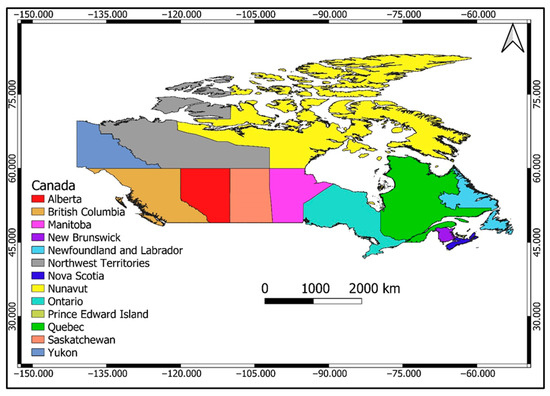
Figure 1.
Map of Canada showing its provinces and territories.
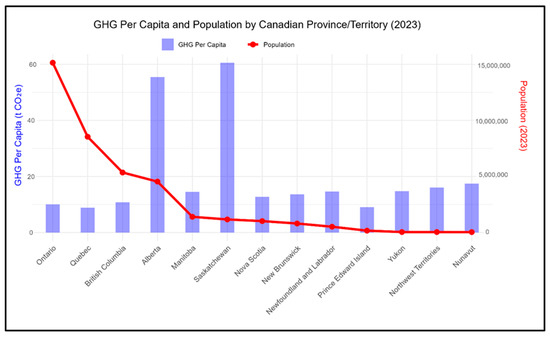
Figure 2.
GHG per capita and population in 2023 according to the provinces and territories.
The dataset used in this study was extracted from the Environment and Climate Change Canada Data Catalogue (available at https://data-donnees.az.ec.gc.ca/data/substances/monitor/canada-s-official-greenhouse-gas-inventory/A-IPCC-Sector/?lang=en, accessed on 1 December 2024). For each province/territory, the following economic sectors (1990–2023) were extracted: agriculture, fugitive sources (hereafter: fugitive), industrial use, stationary combustion sources (hereafter: stationary combustion), transport, and waste. Original GHG values were given in kt CO2 eq and converted to Mt CO2 eq for consistency. In this study, each of the sectors is broadly defined as follows:
- (a)
- Stationary combustion (hereafter: stationary combustion): This is the total GHG emissions from the burning of fossil fuels (oil and gas) from fixed sources that include public electricity and heat production, petroleum refining industries, oil and gas extraction, mining, manufacturing industries, construction, commercial and institutional, residential, agriculture, and forestry.
- (b)
- Transportation (hereafter: transport): This is the total GHG emissions from aviation, road transportation, light-duty gasoline vehicles, light-duty diesel vehicles, motorcycles, light-duty diesel vehicles and trucks, heavy-duty diesel vehicles, propane and natural gas vehicles, railways, and marine vessels.
- (c)
- Fugitive sources (hereafter fugitive): This is the total GHG emissions from unintentional releases such as coal mining, oil, natural gas, venting, and flaring.
- (d)
- Agriculture sources (hereafter: agriculture): This is the total GHG emissions from agricultural economic activities, which include enteric fermentation, manure management, agricultural soils, field burning of agricultural residues, liming, urea application, and other carbon-containing fertilizers.
- (e)
- Waste sources (hereafter waste): This is the total GHG emissions from the waste sector that arise from the decomposition of organic waste in landfills (municipal solid and industrial wood waste), wastewater treatment (municipal and industrial wastewater treatment and discharge), and incineration processes.
Although wildfire emissions are significantly high in places like BC and AB, this study focused on anthropogenic based emissions using the IPCC classification framework. In other words, emissions from other sources such as wildfire, which is categorized under the land use, land-use change, and forestry (LULUCF) are excluded from this study.
2.2. K-Means Machine Learning Algorithm
The K-means machine learning technique is an unsupervised method widely used to group or partition data into K non-overlapping or homogenous clusters or regions [21]. The technique includes (1) randomly initializing K centroids, (2) assigning each data point to the nearest centroid, (3) recomputing centroids as the average of points assigned to each cluster, and (4) repeating steps 2 and 3 until a convergence is reached. The technique minimizes the within-cluster sum of squares (WCSS), thereby grouping similar values.
In other words, given a dataset, (i.e., GHG emissions from each province/territory), the goal is to find K centroids, , such that the following loss function is minimized:
where S = is the partitioning of the GHG emission values. K is a critical step in K-means clustering in determining the number of clusters. Plotting the WCSS against various values of K can indicate the optimal number of clusters. This is the value at the deflection point (i.e., the point where the marginal gain drops sharply) called the “elbow point,” and the method is called the “elbow method” [22]. The WCSS is defined as
2.3. GHG Emission Reduction Projections
This section outlines the rationale behind the aim to reduce emissions to net zero by 2050 (for most provinces, 2040 for PEI) using a linear reduction model, assuming constant annual reductions. For instance, for each province, p, the total emission reduction, Rp (Mt CO2 eq), can be calculated as
where Ep.2023 is the total GHG emissions for 2023, for the province, p, and Tp is the number of years to net zero emissions (27 years for most, 17 years for PEI). The projected emissions, Ep, for year y, were computed as
This ensures emissions remain non-negative and the total reduction is proportionally allocated to each sector, s, within the province using the 2023 emission share given as
where Ep,s,2023 is the 2023 emissions for sector s. Furthermore, the sectoral emissions for year, y, can be projected as
Also, this proportional allocation to the sectoral emissions in each province ensures that sectors with higher emissions will contribute more to reducing emissions, and the non-negative constraint in the equation will prevent unrealistic negative value emissions.
2.4. Carbon Mitigation Initiative’s Stabilization Wedges Concept
This process involves assigning one wedge strategy per sector–province pair. In other words, a strategy will be assigned to the proportion of GHG emission reduction identified in Section 3.3, which will be an actionable climate action that can accelerate the net-zero target. Although the original CMI stabilization wedges concept represents a reduction of approximately one billion tons of carbon emissions per year by mid-century, in this study, a wedge is proportional to the associated or allocated sector–province GHG reduction annual target. Moreover, in the original model, 8 wedges were suggested, and a suite of existing technologies and practices were used; however, 5 wedges, which is the same as the total number of economic sectors, were used and realistic mitigation strategies that reflect current Canadian realities were suggested instead of only including the technologies used in the original concept.
3. Results and Discussions
3.1. Descriptive Statistics of GHG Emissions from Jurisdictions and Economic Sectors
Table 1 shows the provinces’ and territories’ descriptive statistics of GHG emissions. The average GHG emissions for the Prairie provinces between 1990 and 2023 were 244.03 Mt CO2 eq, 20.40 Mt CO2 eq, and 75.97 Mt CO2 eq, for AB, MB, and SK, respectively. During this period, the maximum emissions were 289.48 Mt CO2 eq, 22.45 Mt CO2 eq, and 88.61 Mt CO2 eq for AB, MB, and SK, respectively. The coefficient of variation (CV) was similar in AB and SK at around 12%, whereas that of MB was around 6%. This shows that the economic sectors’ GHG values in AB and SK are more diverse than in MB. For the Central provinces, the average GHG emissions were 81.29 Mt CO2 eq and 178.80 Mt CO2 eq for QC and ON, respectively. For the Atlantic provinces, the GHG emissions were 16.69 Mt CO2 eq, 9.73 Mt CO2 eq, 18.82 Mt CO2 eq, and 1.77 Mt CO2 eq for NB, NL, NS, and PEI, respectively. The maximum emissions were 22.45 Mt CO2 eq, 11.86 Mt CO2 eq, 23.06 Mt CO2 eq, and 2.01 Mt CO2 eq for NB, NL, NS, and PEI, respectively. With its urban transport and industrial emissions mix, a higher CV in NB (18.81%) suggests more significant heterogeneity than in the NL (11.95%), NS (13.93%), and PEI (7.75%) emission profiles. The average emissions from the three territories are 0.65 Mt CO2 eq and 0.58 Mt CO2 eq for NT and NU and YU, respectively. Compared to other provinces, the GHG emissions from these jurisdictions are minimal due to demographic, economic, geographic, and infrastructural factors. The combined population of the three territories is approximately 126,000, which is less than 0.3% of Canada’s total. Therefore, population-driven emissions from the transportation, industry, and energy sectors will be very low. In addition, emissions from agriculture will be low or non-existent due to the Arctic climate, a vast area that limits farming practices, thereby reducing GHG emissions such as methane or N2O. These descriptive statistics of GHG emission profiles above revealed significant provincial and regional variabilities, supporting targeted mitigation strategies across the country.

Table 1.
Descriptive statistics of GHG emissions from provinces/territories between 1990 and 2023.
Table 2 shows the GHG emissions from the Canadian economic sector. For the entire country, the GHG emissions for agriculture, fugitive, industrial use, stationary combustion, transport, and waste are 52.08 Mt CO2 eq, 88.62 Mt CO2 eq, 54.80 Mt CO2 eq, 313.63 Mt CO2 eq, 180.80 Mt CO2 eq, and 19.30 Mt CO2 eq, respectively. Maximum and minimum emissions indicate the range of emission sources within each sector. The stationary combustion high maximum (352.81 Mt CO2 eq), which is from petroleum refining industries, oil and gas extraction, public electricity and heat production, etc., contrasts with waste (20.58 Mt CO2 eq), which is from the treatment and disposal of liquid and solid wastes and indicates a relatively minor role in Canada’s GHG emissions total. Transport (mean: 180.80 Mt CO2 eq) and fugitive emissions (Mean: 88.62 Mt CO2 eq) are significant contributors, followed by industrial use and agriculture. Industrial use and waste have similar CVs (4.66% and 4.17%), which means that the proportional uncertainty or variability in their emission measurements and generation is similar across the country.

Table 2.
Descriptive statistics of GHG emissions from Canadian economic sectors between 1990 and 2023.
3.2. Time Series and Trajectories of GHG Emissions According to Province/Territories
Figure 3 shows each province/territory’s emission profile trajectory from 1990 to 2023. For the Atlantic provinces, it is interesting to see a downward trend from around 2010 to date. This is due to significant efforts to reduce emissions from these provinces. A similar pattern can also be seen in QC and ON. For AB, BC, SK, and MB, there is no striking reduction in the emissions profile, except for the dip seen around 2020 due to the COVID-19 pandemic, when there was a strict shutdown of business activities and restrictions on movement. There is a relatively increased or sustained trajectory in the territories. This is due to an increase in diesel oil consumption in these regions. The GHG emissions composition in 2023, which is used as the reference period in this study, is shown in Figure 4. The 2023 GHG emissions value was used as the base period for projections to 2040. AB and ON still dominate as the highest emitters compared to other jurisdictions. Also, stationary combustion and transport are the highest emitters according to the economic sectors. Fugitive emissions are also high in AB and SK due to emissions escaping from oil and gas activities in these areas. The total GHG emissions for the entire country for 2023 were 693 Mt CO2 eq, which is consistent with the national value reported by ECCC. Detailed discussion of the trend and change point analysis of these regions have been well-captured in Boluwade and Maceachern [6].
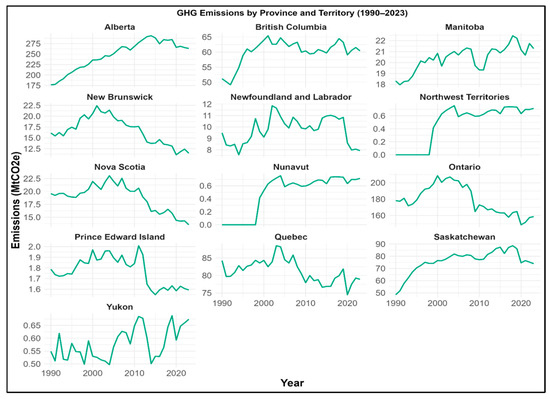
Figure 3.
Time series plot of the GHG emissions in Canada’s jurisdictions (1990–2023).
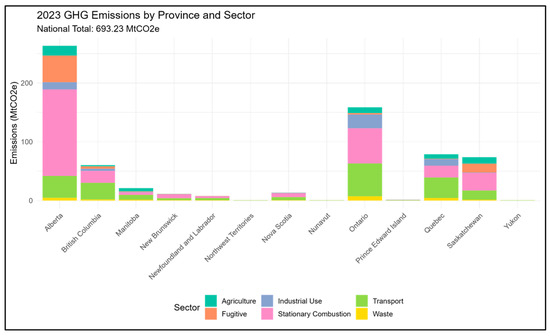
Figure 4.
Total GHG emissions by Canadian province in 2023 (excluding land use) (Mt CO2 eq).
3.3. K-Means and Selection of the Optimal Number of Clusters
The machine learning technique (K-means) was used to cluster the total GHG emissions profile from all the jurisdictions. Figure 5 shows the plot of WSS and the potential number of clusters. WSS shows the compactness of variance within each cluster, meaning that a low value indicates that the GHG data points within each cluster are closer to their respective centroids, suggesting compact, more cohesive clusters. The Elbow method is used to determine the optimal number of clusters to cut off. There is a clear, pronounced, sharp descent at Cluster 5. Beyond this number, there seems to be no more descent. Therefore, five clusters are determined for Canada’s jurisdiction. The five clusters were mapped back to the respective provinces/territories, as shown in Figure 6. The five clusters derived from the analysis are identified as follows:
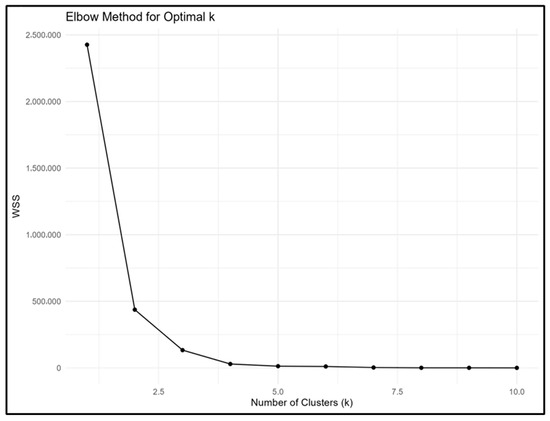
Figure 5.
Optimal number of sectoral GHG emission clusters using the Elbow method.
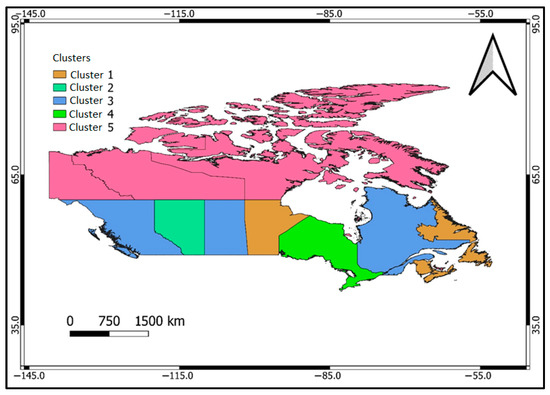
Figure 6.
Derived regionalization of Canadian GHG emissions using the K-means algorithm (1990–2023).
- Cluster 1: MB, NB, NS, and NL
- Cluster 2: AB
- Cluster 3: QC and SK
- Cluster 4: ON and
- Cluster 5: PEI, NT, NU, YK
From the clusters identified above, the highest emitters (Cluster 2 and Cluster 4) are partitioned separately. At the same time, all the intermediate emitters are partitioned separately (Clusters 3 and 1), while the smallest emitters are grouped (Cluster 5). These clusters are realistic as they reflect the GHG emissions of the provinces/territories. The following section will now focus on applications of CMI stabilization wedges to proportions of the GHG emissions required to be reduced by each province-specific sector.
- (a)
- Cluster 1: Manitoba, New Brunswick, Nova Scotia, Newfoundland and Labrador, and Carbon Mitigation Initiative’s Stabilization Wedge Application
Figure 7 shows Cluster 1’s moderate emissions hotspot, which is dominated by stationary combustion (15.56 Mt CO2 eq. and 15.55 Mt CO2 eq.) and transportation (9.06 Mt CO2 eq.) in NS, NB, and MB, reflecting reliance on vehicles and freight across the Atlantic provinces and Manitoba’s mixed economy. Considering the GHG emissions reductions (Figure 8) needed to reach net-zero and the associated actionable climate solutions required for MB, in the transport sector (0.309 Mt CO2 eq/year), incentives need to be provided for EV purchases and to increase rural charging stations targeting Winnipeg’s urban vehicles. In agriculture (0.213 Mt CO2 eq/year), precision agriculture could use soil moisture, nutrient sensors, and variable-rate technology to reduce fertilizer emissions. For stationary combustion (0.151 Mt CO2 eq/year), the energy efficiency protocol could include retrofitting public buildings and homes with geothermal heating systems. Waste (0.051 Mt CO2 eq/year) reduction could include implementing composting and biogas facilities to reduce landfill methane. Industrial Use (0.033 Mt CO2 eq/year) reduction potentials could involve adopting cleaner production techniques in manufacturing (e.g., food processing). Reducing fugitive (0.031 Mt CO2 eq/year) emissions could include methane capture and utilization through installing methane capture at wastewater treatment plants. NB’s emissions reductions in stationary combustion sources (0.241 Mt CO2 eq/year) could include replacing oil-fired power with biomass and tidal energy while leveraging local resources. Furthermore, more electric bus fleets and carpooling programs must be promoted in the transport sector, where 0.124 Mt CO2 eq/year must be cut. By developing regional waste-to-energy plants to process municipal waste, waste-to-energy systems can be implemented in the waste sector, where 0.025 Mt CO2 eq/year is required to reach net-zero. In the agriculture sector, sustainable livestock management involves methane inhibitors for cattle, and rotational grazing will drastically reduce the 0.015 Mt CO2 eq/year emissions. Process optimization techniques include optimizing refinery and pulp mill operations with energy-efficient equipment or real-time energy usage monitoring, which could help reduce the 0.012 Mt CO2 eq/year in the industrial use sector. GHG emissions from fugitive sources (0.008 Mt CO2 eq/year) could be reduced through capturing methane from small-scale industrial leaks. For NL, emissions from stationary combustion and transport dominate, and strategies similar to those of NB can also be implemented for the economic sectors. Renewable microgrids can support fishing vessels and ferries to cut the 0.139 Mt CO2 eq/year required in the transport sector. Furthermore, emissions from stationary combustion sources (0.109 Mt CO2 eq/year) can be reduced through a transition to renewable energy, such as expanding the hydroelectric capacity (e.g., Muskrat Falls) to replace diesel generators. The emission reductions required in the waste sector (0.021 Mt CO2 eq/year) can be achieved through developing small-scale anaerobic digesters for remote communities. Methane from offshore oil platforms, upgrading fish processing plants with low-emission technologies, and optimizing small-scale farming with methane-reducing practices can help cut 0.014 Mt CO2 eq/year, 0.007 Mt CO2 eq/year, and 0.003 Mt CO2 eq/year emissions from fugitive, industrial use, and agriculture, respectively.

Figure 7.
Maximum GHG emissions from Canadian economic sectors in derived clusters.
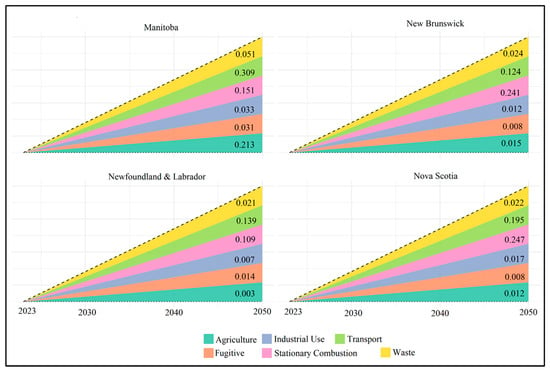
Figure 8.
Region 1: Clustered greenhouse gas emissions in Canada (1990–2023).
- (b)
- Cluster 2: Alberta GHG Emissions Standalone Cluster and Carbon Mitigation Initiative’s Stabilization Wedge Application
This is a standalone cluster, which is an indication of AB’s outsized GHG emissions. As shown in Figure 4, this cluster is dominated by stationary combustion and transport, having maximum GHG emissions of 160.87 Mt CO2 eq., 62.03 Mt CO2 eq., and 42.28 Mt CO2 eq. for stationary combustion, fugitive, and transport, respectively. These relatively large emissions are due to varied emission sources such as oil sands and natural gas facilities (ECCC, 2025). The annual GHG emissions reduction target required for AB includes 0.173 Mt CO2 eq., 1.380 Mt CO2 eq., 5.447 Mt CO2 eq., 0.457 Mt CO2 eq., 1.671 Mt CO2 eq., and 0.625 Mt CO2 eq. for waste, transport, stationary combustion, industrial use, fugitive, and agriculture, respectively (Figure 9). The five CMI stabilization wedges suggested to meet these reduction targets include a transition to renewable energy, methane capture and utilization, the electrification of transport, precision agriculture, and CCS. Considering the dominance of stationary combustion in Alberta, actionable climate solutions could include accelerating the shift from coal and natural gas power plants to wind, solar, and hydroelectric power. This will leverage Alberta’s considerable renewable energy potential (e.g., the wind power potential in southern Alberta). The fugitive GHG emissions reduction could include deploying advanced leak detection and repair systems in oil and gas operations, capturing methane for energy use, or flaring reduction. Moreover, the transport sector initiatives could include expanding electric vehicle (EV) infrastructure and incentivizing EV adoption for personal and freight transportation. This could target oil sands-related stocks of vehicles. Emissions in the agricultural sector could be reduced by implementing precision farming technologies or variable rate irrigation, which include using GPS-guided equipment to optimize fertilizer use and application in the prairies. This will reduce nitrous oxide emissions. In the Industrial sector, CCS applications and techniques include retrofitting cement and chemical plants with CCS to capture CO2 emissions at source. This will also leverage Alberta’s geological storage capacity. In the waste sector, a context-based approach could include developing anaerobic digestion and incineration facilities to convert organic waste into energy.
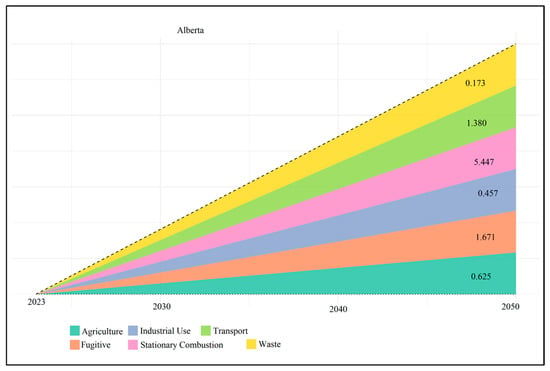
Figure 9.
Region 2: Clustered greenhouse gas emissions in Canada (1990–2023).
- (c)
- Cluster 3: British Columbia, Quebec, and Saskatchewan GHG Emissions Standalone Cluster And Carbon Mitigation Initiative’s Stabilization Wedge Application
This cluster includes provinces with intermediate emission profiles. The heatmap in Figure 4 shows that emissions from stationary combustion and transportation dominated this cluster. There are high emissions from SK from agricultural and fugitive sources. This shows that climate solutions that focus on energy reduction strategies, electrifying the transportation sector, precision agriculture through site-specific nutrient and water management, and modern methane monitoring should be prioritized for this cluster. For QC (Figure 10), the transport sector must cut 1.293 Mt CO2 eq/year, which can be achieved by electrifying Montreal’s metro and rural vehicle fleets. Furthermore, throughout the province, more electric buses should be added to popular routes, including an increase in the frequency of the buses. For stationary combustion, 0.742 Mt CO2 eq/year must be cut through retrofitting older buildings in Montreal, Quebec City, etc., with hydroelectric-powered heat pumps. CCS can be applied to decrease the 0.416 Mt CO2 eq/year in the Industrial Use sector. The agriculture sector must reduce emissions by 0.293 Mt CO2 eq/year, which can be achieved using methane digesters for dairy operations. The expansion of waste-to-energy initiatives in urban areas in QC can help reach the target of 0.162 Mt CO2 eq/year required in the waste sector. Capturing methane from pulp mills in places like Trois-Rivières, Matane, Clermont, Château-Richer, and Dolbeau-Mistassini can significantly reduce the 0.017 Mt CO2 eq/year from fugitive sources. In SK, the transition to renewable energy through a shift from coal to solar and wind farms would help bring emissions from stationary combustion sources (1.105 Mt CO2 eq/year) to zero by 2050. A fugitive emissions reduction of 0.554 Mt CO2 eq/year could be achieved through enhanced methane capture in oil and gas fields. In the Agricultural sector, GHG emissions of 0.413 Mt CO2 eq/year can be reduced through precision agriculture using satellite-guided and proximal soil sensing, farming nutrient application, and efficient water management. The development of regional biogas plants can help achieve the 0.052 Mt CO2 eq/year reduction needed in the waste sector. Furthermore, industrial optimization by applying cleaner technologies in fertilizer production can help achieve the 0.030 Mt CO2 eq/year reduction required in the Industrial Use sector.
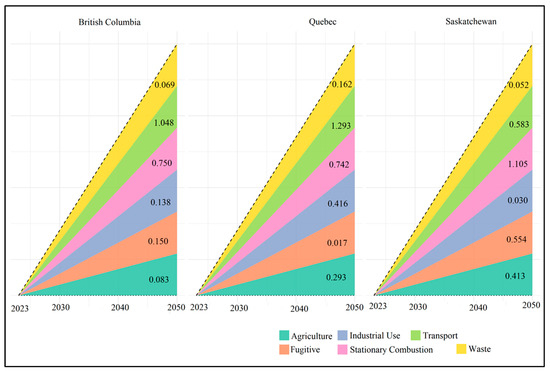
Figure 10.
Region 3: Clustered greenhouse gas emissions in Canada (1990–2023).
For BC to reach net-zero in 2050, the province is required to reduce GHG emissions annually by 1.048 Mt CO2 eq, 0.750 Mt CO2 eq, 0.150 Mt CO2 eq, 0.138 Mt CO2 eq, 0.083 Mt CO2 eq and 0.069 Mt CO2 eq in transport, stationary combustion, fugitive, industrial use, agriculture, and waste, respectively. Applying the CMI stabilization wedge, emissions reductions in the transport sector could include expanding and increasing rebates for EV, expanding EV charging networks, electrifying public transit (e.g., BC Ferries), and building on existing CleanBC initiatives. Stationary combustion emissions reductions can be achieved by mandating retrofits for buildings and industrial facilities to reduce heating and power emissions using heat pumps and insulation. Enhancing methane capture from landfills and natural gas infrastructure, which can be converted to biogas, will target the emissions from fugitive sources. Industrial Use emissions reductions could include upgrading industrial processes in pulp and paper factories with low-emissions technologies and alternative fuels. Promoting methane-reducing feed additives and manure management systems can help tackle GHG emissions from the agricultural sector. Developing anaerobic digestion and incineration facilities to convert organic waste into energy can reduce emissions in the waste sector.
- (d)
- Cluster 4: Ontario GHG Emissions Standalone Cluster and Carbon Mitigation Initiative’s Stabilization Wedge Application
ON is a standalone cluster and one of Canada’s dominant sources of GHG emissions. For this province to reach net-zero by 2050, ambitious, yet doable and proactive, strategies are required. The province’s GHG emissions are dominated by up to 104.09 Mt CO2 eq., 63.93 Mt CO2 eq., and 31.98 Mt CO2 eq. in stationary combustion, transport, and industrial use, respectively. Using the 2023 GHG emissions as the reference period, annually (Figure 11), 2.217 Mt CO2 eq, 2.069 Mt CO2 eq, 0.867 Mt CO2 eq, 0.374 Mt CO2 eq, 0.269 Mt CO2 eq, and 0.083 Mt CO2 eq must be cut in the stationary combustion, transport, industrial use, agriculture, waste and fugitive sources, respectively. Applying the CMI stabilization wedge concept, energy efficiency retrofitting industrial and residential buildings with heat pumps and smart grids can significantly reduce energy usage and reduce stationary combustion emissions by expanding the infrastructure and electrifying GO Transit. Emissions from the transport sector can be reduced, especially in the Greater Toronto Area (GTA). Moreover, the provincial government should provide more incentives for adopting an EV fleet. CCS technologies can be applied to steel and cement plants in Southern Ontario to drastically reduce the Industrial Use sector’s emissions. By deploying drones, satellites, aerial-borne sensors, and proximal soil sensors for fertilizer management, precision agriculture can help reduce emissions in the agricultural sector. Initiatives can include scaling up anaerobic digestion in urban centers like Toronto, London, Waterloo, and Mississauga, which can reduce GHG emissions from the waste sector. Fugitive emissions can be captured from landfills and wastewater using methane capture and utilization protocols.
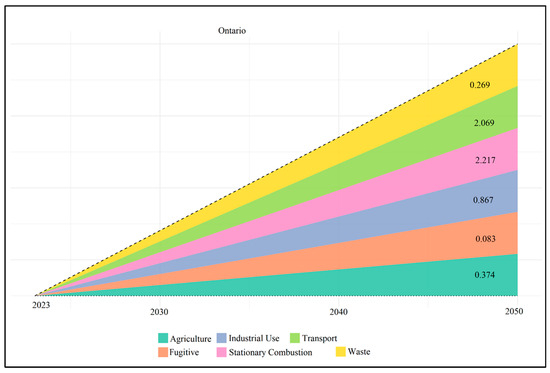
Figure 11.
Region 4: Clustered greenhouse gas emissions in Canada (1990–2023).
- (e)
- Cluster 5: Prince Edward Island, Northwest Territories, Nunavut, and Yukon emissions standalone cluster and carbon mitigation initiative’s stabilization wedge application
Cluster 5 encompasses PEI and the territories, as seen in Figure 6. The heatmap shows that GHG emissions from transportation dominate this cluster. This is due to personal vehicle usage in most of these jurisdictions. PEI dominates this cluster with emissions as high as 0.89 Mt CO2 eq, 0.76 Mt CO2 eq, and 0.34 Mt CO2 eq in the transport, stationary combustion, and agriculture sectors. This province has an ambition of being the first Canadian province to reach net-zero, with a 2040 target. Therefore, using 2023 as the reference, we linearly project the net-zero to 2040 for PEI (Figure 12). The GHG emissions need to be annually reduced by 0.047 Mt CO2 eq, 0.022 Mt CO2 eq, 0.017 Mt CO2 eq, 0.004 Mt CO2 eq, 0.003 Mt CO2 eq, and 0.00006 Mt CO2 eq in the transport, stationary combustion, agriculture, waste, and industrial use sectors, respectively. Public transit enhancement is key for the transport sector, which contributes more than 40% of PEI’s total emissions. This could include electrifying buses, increasing rural transit routes, simplifying road networks, and promoting cycling infrastructure. Stationary combustion GHG emissions could be reduced through increasing renewable energy, which could expand the wattage of wind farms, and government subsidies to replace oil heating with heat pumps. Emissions from agriculture (0.017 Mt CO2 eq) can be reduced through precision agriculture in potato farming that uses variable rate irrigation and fertilization. Best management practices, such as nutrient application timing and methane monitoring from animal husbandry, can contribute to annual GHG emissions reductions. Composting and small-scale biogas for waste in the three areas can significantly reduce waste emissions. Food processing can be upgraded with energy-efficient systems. Methane capture and utilization technologies can handle the small amounts of emissions from the Industrial Use sector. In NT, there are no emissions from agriculture and fugitive due to the Arctic climate, which allows only limited or no farming practices. Other sectors such as transport, stationary combustion, waste, and industrial use will require an annual GHG reduction of 0.019 Mt CO2 eq, 0.006 Mt CO2 eq, 0.002 Mt CO2 eq, and 0.001 Mt CO2 eq, respectively. The CMI stabilization wedges for these sectors could include deploying EV and hybrid vehicles for private and government fleets in the transport sector. In the stationary combustion, Waste and Industrial Use sectors, climate solutions could include retrofitting remote diesel-powered homes, government facilities with solar, expanding battery storage, using micro-scale environmental incineration for waste generated in isolated communities, and enhancing mining operations with energy-efficient machinery through Internet of Things (IoT) technology. NU also lacks emissions from both agricultural and fugitive sources for the same reason mentioned above; however, annual emission reductions of 0.019 Mt CO2 eq, 0.006 Mt CO2 eq, 0.002 Mt CO2 eq, and 0.001 Mt CO2 eq are needed for the transport, stationary combustion, waste, and industrial use sectors, respectively. The CMI stabilization wedges for this territory could include efficient electric or hybrid snowmobiles and ATVs for community use. Transitioning to renewable energy sources, such as wind farms, could replace diesel with wind-diesel hybrid systems in remote grids, drastically reducing stationary combustion emissions. Implementing small-scale waste, environmentally friendly incineration, and energy recovery could help reduce emissions from the waste sector. The optimization of small industrial activities (e.g., construction) with efficient equipment could help cut the emissions from Industrial Use. For YK, an annual GHG emission reduction of 0.020 Mt CO2 eq, 0.003 Mt CO2 eq, and 0.001 Mt CO2 eq is required in the transport, stationary combustion, and waste (also in Industrial Use) sectors, respectively. No emissions reduction is required in the agricultural and fugitive sectors, though a maximum GHG emission of 0.01 Mt CO2 eq has been recorded for fugitive in the past (Figure 4). To address this, an efficient monitoring system would be required in the fugitive sector. For this territory to reach net-zero by 2050, the transport sector must be electrified, with the government promoting EVs in Whitehorse through rebates and incentives. EV infrastructure, such as charging stations, should be made available. The Stationery Combustion sector must retrofit old buildings, cottages, and off-grid cabins with solar panels and heat efficiency through insulation rebates and programs. Using micro-digesters for community waste can help cut the GHG emissions from the waste sector. New and efficient machinery in the mining sector can help reduce emissions from the Industrial sector. Due to challenges facing the Canadian territories from the location and socio-economic perspective, knowledge sharing and collaboration with other jurisdictions should be promoted, especially the sharing of best practices for what works in various sectors.
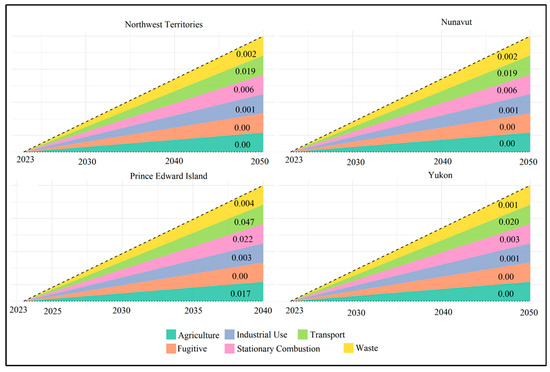
Figure 12.
Region 5: Clustered greenhouse gas emissions in Canada (1990–2023).
This study used a linear reduction technique from 2023 to 2050 and from 2040 for all Canadian jurisdictions and for PEI, respectively. The methodology can be refined for future studies by employing a non-linear model that uses artificial intelligence. Methods such as long short-term memory (LSTM) neural networks can be used to model the non-linear trajectories of GHG emissions from sectoral profiles, thereby capturing the complex relationships between socio-economic, technological, and policy indicators that impact GHG reductions. Using historical emissions from 1990 to 2023, LSTM can be trained, and external covariates such as economic indicators (e.g., GDP, industrial output), energy data (e.g., renewable energy adoption rates, fossil fuel consumption), policy variables (e.g., carbon pricing, subsidy levels), and technological factors (e.g., CCS deployment costs, EV penetration) can be integrated into the model to provide a more realistic pathway to net-zero by 2050 (2040 for PEI). It would also be interesting to apply advanced clustering techniques, such as variational autoencoders (VAEs), that can identify latent patterns in the emissions dataset. VAEs will potentially help reveal new groupings or clusters based on sectoral or temporal dynamics picked up by the k-means clustering method. There are still gaps in understanding the relationship between GHG emissions trajectories and climatic variables (e.g., temperature trends, degree days, relative humidity, extreme weather frequency). Future studies will also integrate the dynamics of various economic factors and possibly the associated estimated costs, budget constraints, and potential impact of tariff threats for each climate solution suggested for a more realistic recommendation.
4. Conclusions
The study evaluated and developed a practical framework for how Canada can reach net zero by 2050 (2040 for PEI) using the current GHG emission trajectories. This evaluation was performed through regionalization to produce clusters using an unsupervised machine-learning method. The derived clusters show similar GHG emissions trajectories, which helps develop tangible and manageable climate actions. A few concluding remarks are drawn from this study:
- (a)
- The K-means clustering technique produced the WSS, which helped in identifying the following clusters: Cluster 1: MB, NB, NS, and NL; Cluster 2: AB; Cluster 3: QC and SK; Cluster 4: ON; and Cluster 5: PEI, NT, and NU.
- (b)
- GHG emissions from the stationary combustion and transport sectors dominated all clusters, except in Clusters 2 and 4, respectively, where significant fugitive and industrial use emissions exist.
- (c)
- For the maximum GHG reduction required (Clusters 1–5), 0.309 Mt CO2 eq/year, 5.447 Mt CO2 eq/year, 1.293 Mt CO2 eq/year, 2.217 Mt CO2 eq/year, and 0.04 Mt CO2 eq/year must be targeted from MB (transport), AB (stationary combustion), QC (transport), ON (stationary combustion) and PEI (Transport).
The wedges framework makes Canada’s net-zero goal manageable. This approach makes climate change mitigation at the national scale succinct and clear from a strategic management perspective. The various national climate action programs can use the results from this study as resources for climate change mitigation. The policy implication of this study means all Canadian jurisdictions need customized, sector-specific plans that can lead the way to net zero in 2040 in PEI and 2050 for all other areas. In other words, these localized and regionalized climate mitigation actions will ultimately lead to the bigger picture of Canada reaching net zero by 2050.
Funding
This research received no external funding.
Institutional Review Board Statement
Not applicable.
Informed Consent Statement
Not applicable.
Data Availability Statement
Datasets for Canada’s official greenhouse gas inventory are available at https://www.canada.ca/en/environment-climate-change/services/climate-change/greenhouse-gas-emissions/inventory.html (accessed on 2 December 2024).
Acknowledgments
The author would like to thank the three anonymous reviewers for their useful suggestions, which helped improve the quality of this paper.
Conflicts of Interest
The author declares no conflicts of interest.
References
- Crippa, M.; Guizzardi, D.; Muntean, M.; Schaaf, E.; Monforti-Ferrario, F.; Olivier, J.G.J.; Vignati, E. GHG Emissions of All World Countries—2024 Report; Publications Office of the European Union: Luxembourg, 2024; Available online: https://edgar.jrc.ec.europa.eu/report_2024 (accessed on 6 January 2025).
- Government of Canada. 2030 Emissions Reduction Plan: Clean Air, Strong Economy; Environment and Climate Change Canada: Ottawa, ON, Canada, 2024. Available online: https://www.canada.ca/en/services/environment/weather/climatechange/climate-plan/climate-plan-overview/emissions-reduction-2030.html (accessed on 6 January 2025).
- Government of Canada. Greenhouse Gas Emissions: Oil and Gas Sector; Environment and Climate Change Canada: Ottawa, ON, Canada, 2025. Available online: https://www.canada.ca/en/environment-climate-change/services/environmental-indicators/greenhouse-gas-emissions.html (accessed on 6 January 2025).
- Environment and Climate Change Canada. Early 2023 Greenhouse Gas Estimates Show Canada’s Climate Plan Is Working: Emissions Have Dropped to Their Lowest Level in 27 Years (Excluding Pandemic Years). 2025. Available online: https://www.newswire.ca/news-releases/early-2023-greenhouse-gas-estimates-show-canada-s-climate-plan-is-working-emissions-have-dropped-to-their-lowest-level-in-27-years-excluding-pandemic-years--853789229.html (accessed on 6 January 2025).
- Canada Energy Regulator. Market Snapshot: Canadian Coal-Fired Electricity Generation Is Rapidly Being Replaced by Low and Non-Emitting Energy Sources. 2024. Available online: https://www.cer-rec.gc.ca/en/data-analysis/energy-markets/market-snapshots/2024/market-snapshot-canadian-coal-fired-electricity-generation-rapidly-being-replaced-low-non-emitting-energy-sources.html (accessed on 6 January 2025).
- Boluwade, A.; Maceachern, J. The road to net-zero in Canada through regionalization and segmentation of GHG emissions and the role of water resources management. J. Water Clim. Change 2024, 15, 3919–3938. [Google Scholar] [CrossRef]
- Liu, Y.; Sun, Y.; Yang, G. Carbon emission clustering and low-carbon policy design in China. J. Clean. Prod. 2019, 227, 1187–1196. [Google Scholar] [CrossRef]
- García-Álvarez, M.T.; Moreno, B.; Soares, I. CO2 emissions in European countries: A clustering approach. Energy Policy 2018, 121, 465–474. [Google Scholar] [CrossRef]
- Zhang, X.; Wang, Q. Emission-based clustering of power plants for energy transition. Renew. Sustain. Energy Rev. 2021, 145, 111089. [Google Scholar] [CrossRef]
- Gallardo-Romero, D.J.; Apolo-Apolo, O.E.; Martínez-Guanter, J.; Pérez-Ruiz, M. Multilayer Data and Artificial Intelligence for the Delineation of Homogeneous Management Zones in Maize Cultivation. Remote Sens. 2023, 15, 3131. [Google Scholar] [CrossRef]
- Pacala, S.; Socolow, R. Stabilization wedges: Solving the climate problem for the next 50 years with current technologies. Science 2004, 305, 968–972. [Google Scholar] [CrossRef] [PubMed]
- Davis, S.J.; Lewis, N.S.; Shaner, M.; Aggarwal, S.; Arent, D.; Azevedo, I.L.; Benson, S.M.; Bradley, T.; Brouwer, J.; Chiang, Y.-M.; et al. Net-zero emissions energy systems. Science 2018, 360, eaas9793. [Google Scholar] [CrossRef] [PubMed]
- Grosso, S.J.D.; Cavigelli, M. A Climate Stabilization Wedges Revisited: Can Agricultural Production and Greenhouse-Gas Reduction Goals Be Accomplished? Front. Ecol. Environ. 2012, 10, 571–578. [Google Scholar] [CrossRef]
- Population Estimates, Quarterly. Available online: https://www150.statcan.gc.ca/t1/tbl1/en/tv.action?pid=1710000901 (accessed on 6 January 2025).
- Statistics Canada. Geography. Available online: https://www150.statcan.gc.ca/n1/pub/11-402-x/2011000/chap/geo/geo-eng.htm (accessed on 6 January 2025).
- Environment and Climate Change Canada. Canadian Climate Normals 1981–2010. Available online: https://climate.weather.gc.ca/climate_normals/ (accessed on 6 January 2025).
- International Monetary Fund. World Economic Outlook Database, April 2024. Available online: https://www.imf.org/en/Publications/WEO/weo-database/2024/April (accessed on 6 January 2025).
- Environment and Climate Change Canada. National Inventory Report 1990–2022: Greenhouse Gas Sources and Sinks in Canada. Available online: https://www.canada.ca/en/environment-climate-change/services/climate-change/greenhouse-gas-emissions/inventory.html (accessed on 6 January 2025).
- Statistics Canada. Population and Demography Statistics. Available online: https://www.statcan.gc.ca/en/subjects-start/population_and_demography (accessed on 6 January 2025).
- Environment and Climate Change Canada, Projected Economic and Emissions Profiles. 2025. Available online: https://www.canada.ca/en/environment-climate-change/services/climate-change.html (accessed on 6 January 2025).
- MacQueen, J.B. Some methods for classification and analysis of multivariate observations. In Proceedings of the Fifth Berkeley Symposium on Mathematical Statistics and Probability, Berkeley, CA, USA, 18–21 July 1965; University of California Press: Berkeley, CA, USA, 1967; Volume 1, pp. 281–297. [Google Scholar]
- Thorndike, R.L. Who belongs in the family? Psychometrika 1953, 18, 267–276. [Google Scholar] [CrossRef]
Disclaimer/Publisher’s Note: The statements, opinions and data contained in all publications are solely those of the individual author(s) and contributor(s) and not of MDPI and/or the editor(s). MDPI and/or the editor(s) disclaim responsibility for any injury to people or property resulting from any ideas, methods, instructions or products referred to in the content. |
© 2025 by the author. Licensee MDPI, Basel, Switzerland. This article is an open access article distributed under the terms and conditions of the Creative Commons Attribution (CC BY) license (https://creativecommons.org/licenses/by/4.0/).